Assessment la: Team Briefing Essay on Cross-Cultural Communication
VerifiedAdded on 2022/08/18
|14
|3448
|13
Essay
AI Summary
This essay provides a critical analysis of cross-cultural communication, focusing on the challenges and opportunities for exporters from Palmerston North, New Zealand, expanding their business to India. It begins with an introduction to globalization and the importance of understanding cultural differences in international business, emphasizing the need for effective cross-cultural communication. The essay then outlines the context of a group of exporters planning a business trip to India, highlighting the differences between New Zealand and Indian business cultures. It utilizes Hofstede's model to compare the national cultures of both countries, examining key dimensions such as power distance, individualism, masculinity, uncertainty avoidance, long-term orientation, and indulgence. The essay then offers practical adjustments that the exporters need to make, including communication styles, language considerations, work environment adaptations, greeting customs, gender sensitivity, and awareness of time, dress, and appearance. The essay concludes by summarizing the impact of national culture on business practices and the importance of cultural sensitivity for international business success.
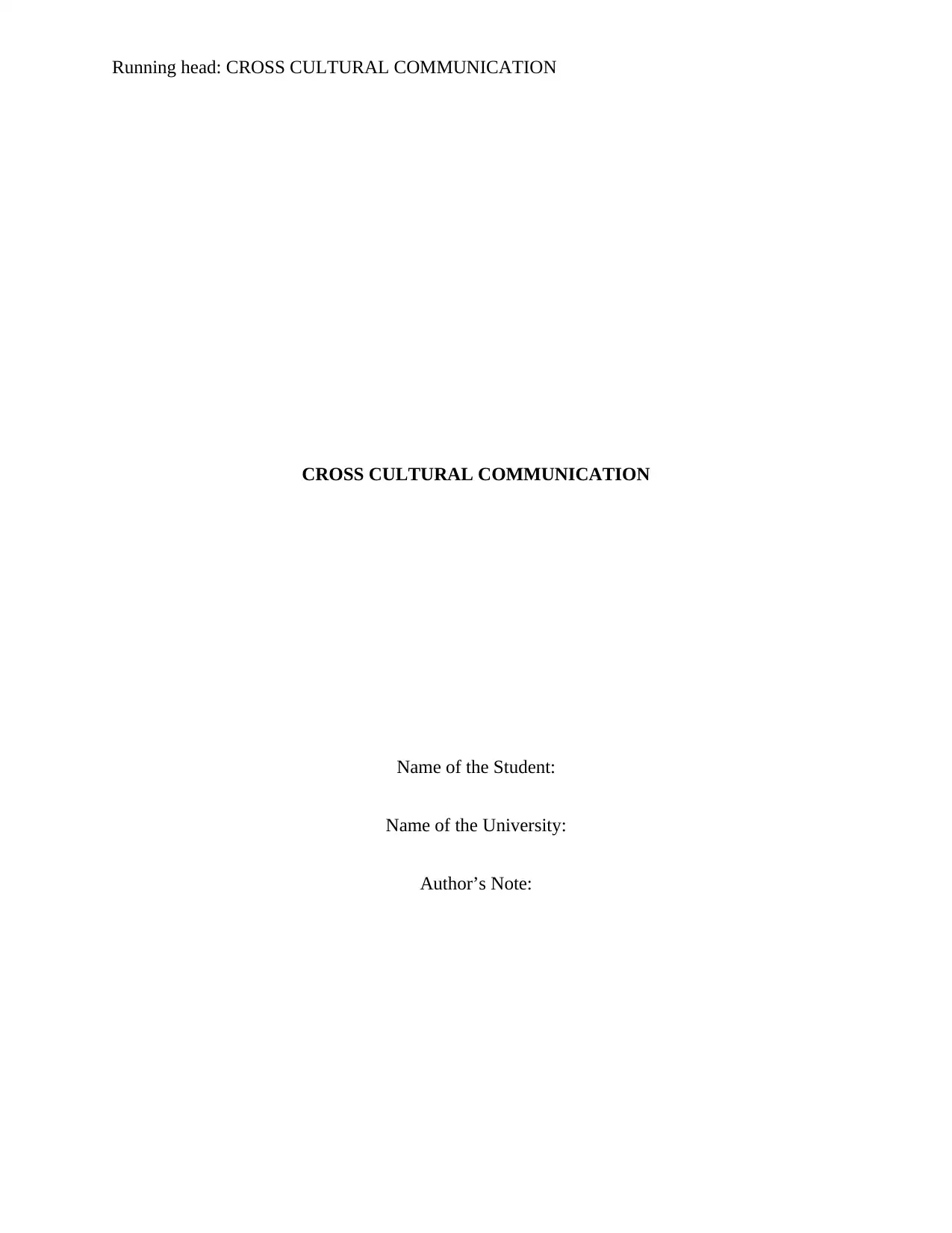
Running head: CROSS CULTURAL COMMUNICATION
CROSS CULTURAL COMMUNICATION
Name of the Student:
Name of the University:
Author’s Note:
CROSS CULTURAL COMMUNICATION
Name of the Student:
Name of the University:
Author’s Note:
Paraphrase This Document
Need a fresh take? Get an instant paraphrase of this document with our AI Paraphraser
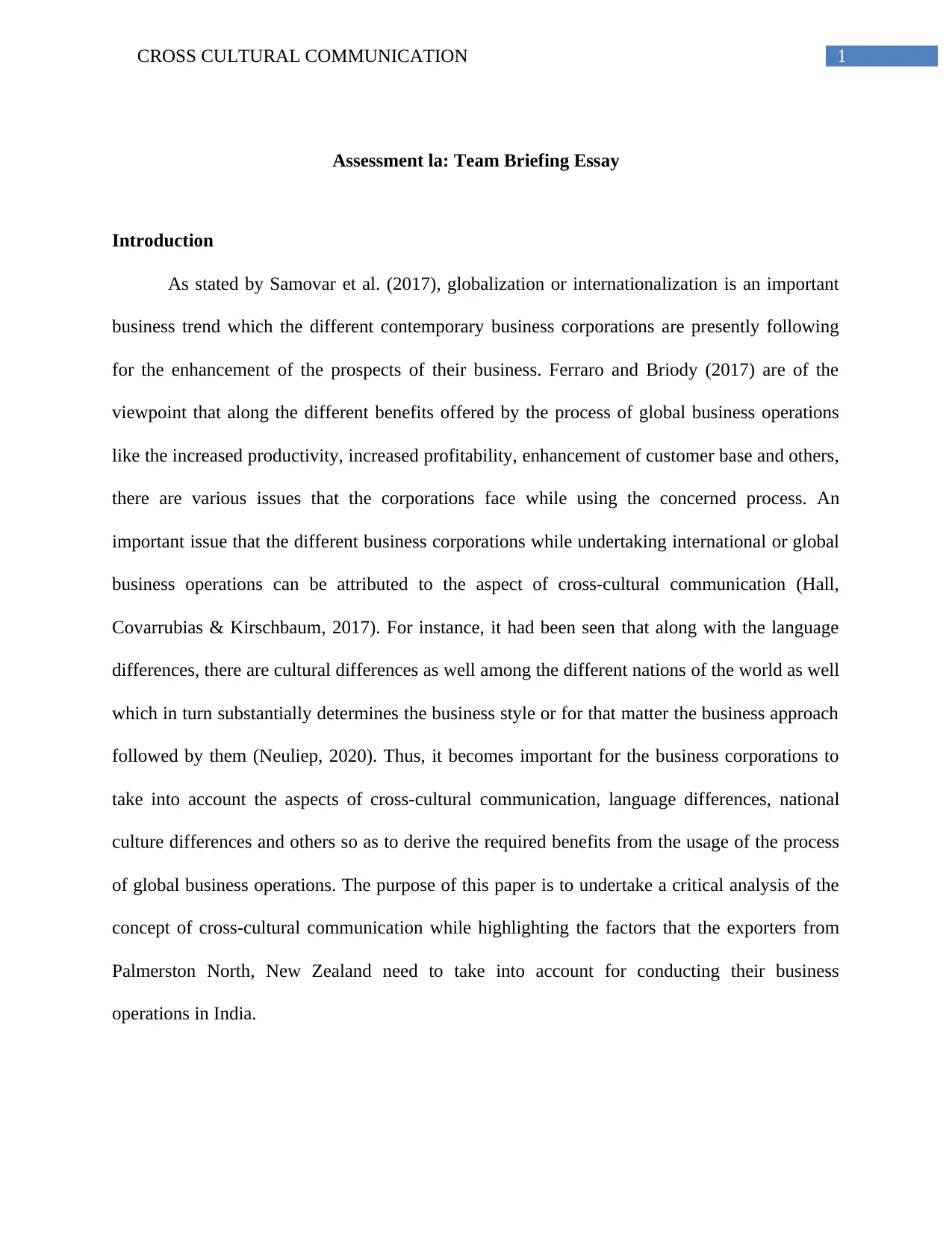
1CROSS CULTURAL COMMUNICATION
Assessment la: Team Briefing Essay
Introduction
As stated by Samovar et al. (2017), globalization or internationalization is an important
business trend which the different contemporary business corporations are presently following
for the enhancement of the prospects of their business. Ferraro and Briody (2017) are of the
viewpoint that along the different benefits offered by the process of global business operations
like the increased productivity, increased profitability, enhancement of customer base and others,
there are various issues that the corporations face while using the concerned process. An
important issue that the different business corporations while undertaking international or global
business operations can be attributed to the aspect of cross-cultural communication (Hall,
Covarrubias & Kirschbaum, 2017). For instance, it had been seen that along with the language
differences, there are cultural differences as well among the different nations of the world as well
which in turn substantially determines the business style or for that matter the business approach
followed by them (Neuliep, 2020). Thus, it becomes important for the business corporations to
take into account the aspects of cross-cultural communication, language differences, national
culture differences and others so as to derive the required benefits from the usage of the process
of global business operations. The purpose of this paper is to undertake a critical analysis of the
concept of cross-cultural communication while highlighting the factors that the exporters from
Palmerston North, New Zealand need to take into account for conducting their business
operations in India.
Assessment la: Team Briefing Essay
Introduction
As stated by Samovar et al. (2017), globalization or internationalization is an important
business trend which the different contemporary business corporations are presently following
for the enhancement of the prospects of their business. Ferraro and Briody (2017) are of the
viewpoint that along the different benefits offered by the process of global business operations
like the increased productivity, increased profitability, enhancement of customer base and others,
there are various issues that the corporations face while using the concerned process. An
important issue that the different business corporations while undertaking international or global
business operations can be attributed to the aspect of cross-cultural communication (Hall,
Covarrubias & Kirschbaum, 2017). For instance, it had been seen that along with the language
differences, there are cultural differences as well among the different nations of the world as well
which in turn substantially determines the business style or for that matter the business approach
followed by them (Neuliep, 2020). Thus, it becomes important for the business corporations to
take into account the aspects of cross-cultural communication, language differences, national
culture differences and others so as to derive the required benefits from the usage of the process
of global business operations. The purpose of this paper is to undertake a critical analysis of the
concept of cross-cultural communication while highlighting the factors that the exporters from
Palmerston North, New Zealand need to take into account for conducting their business
operations in India.
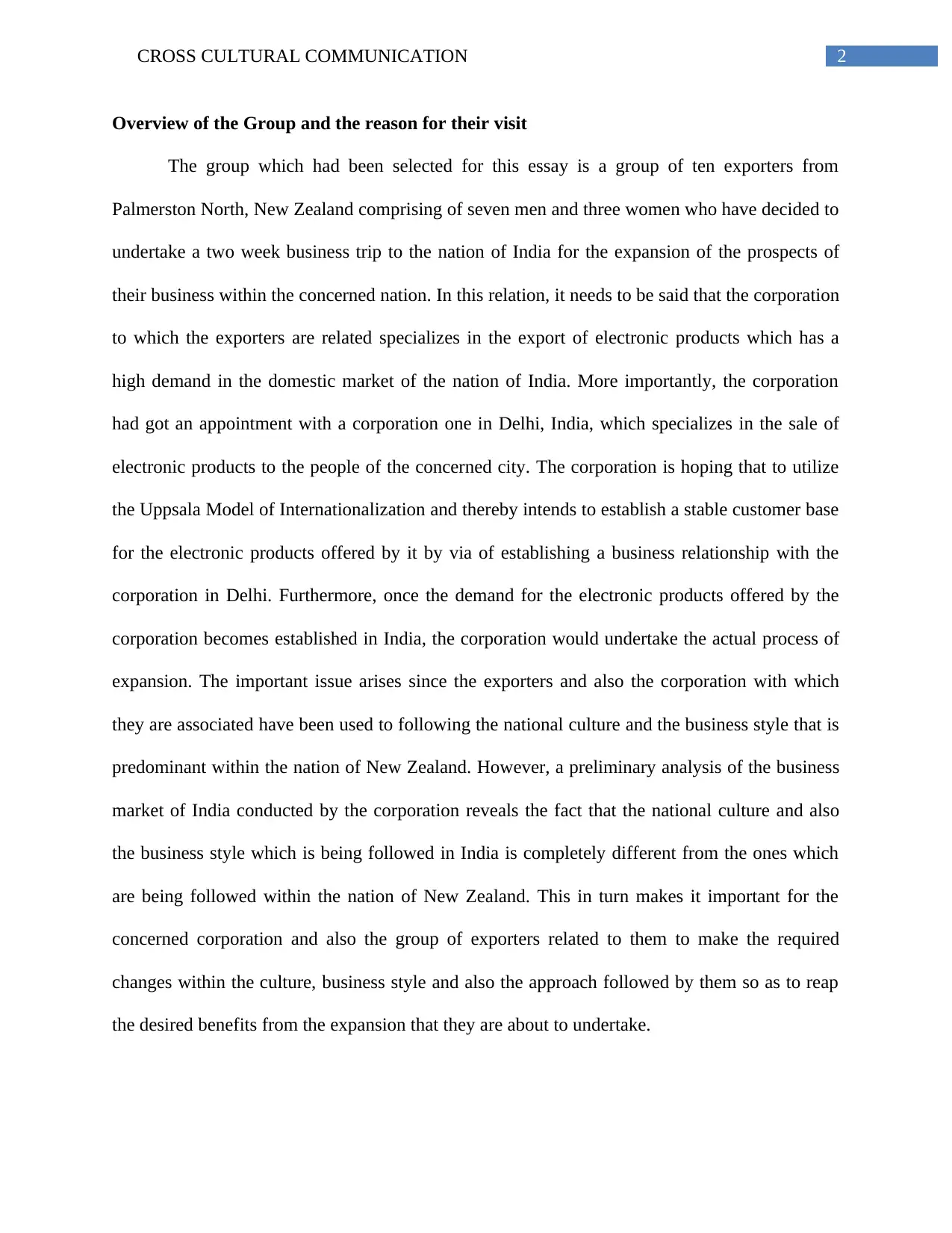
2CROSS CULTURAL COMMUNICATION
Overview of the Group and the reason for their visit
The group which had been selected for this essay is a group of ten exporters from
Palmerston North, New Zealand comprising of seven men and three women who have decided to
undertake a two week business trip to the nation of India for the expansion of the prospects of
their business within the concerned nation. In this relation, it needs to be said that the corporation
to which the exporters are related specializes in the export of electronic products which has a
high demand in the domestic market of the nation of India. More importantly, the corporation
had got an appointment with a corporation one in Delhi, India, which specializes in the sale of
electronic products to the people of the concerned city. The corporation is hoping that to utilize
the Uppsala Model of Internationalization and thereby intends to establish a stable customer base
for the electronic products offered by it by via of establishing a business relationship with the
corporation in Delhi. Furthermore, once the demand for the electronic products offered by the
corporation becomes established in India, the corporation would undertake the actual process of
expansion. The important issue arises since the exporters and also the corporation with which
they are associated have been used to following the national culture and the business style that is
predominant within the nation of New Zealand. However, a preliminary analysis of the business
market of India conducted by the corporation reveals the fact that the national culture and also
the business style which is being followed in India is completely different from the ones which
are being followed within the nation of New Zealand. This in turn makes it important for the
concerned corporation and also the group of exporters related to them to make the required
changes within the culture, business style and also the approach followed by them so as to reap
the desired benefits from the expansion that they are about to undertake.
Overview of the Group and the reason for their visit
The group which had been selected for this essay is a group of ten exporters from
Palmerston North, New Zealand comprising of seven men and three women who have decided to
undertake a two week business trip to the nation of India for the expansion of the prospects of
their business within the concerned nation. In this relation, it needs to be said that the corporation
to which the exporters are related specializes in the export of electronic products which has a
high demand in the domestic market of the nation of India. More importantly, the corporation
had got an appointment with a corporation one in Delhi, India, which specializes in the sale of
electronic products to the people of the concerned city. The corporation is hoping that to utilize
the Uppsala Model of Internationalization and thereby intends to establish a stable customer base
for the electronic products offered by it by via of establishing a business relationship with the
corporation in Delhi. Furthermore, once the demand for the electronic products offered by the
corporation becomes established in India, the corporation would undertake the actual process of
expansion. The important issue arises since the exporters and also the corporation with which
they are associated have been used to following the national culture and the business style that is
predominant within the nation of New Zealand. However, a preliminary analysis of the business
market of India conducted by the corporation reveals the fact that the national culture and also
the business style which is being followed in India is completely different from the ones which
are being followed within the nation of New Zealand. This in turn makes it important for the
concerned corporation and also the group of exporters related to them to make the required
changes within the culture, business style and also the approach followed by them so as to reap
the desired benefits from the expansion that they are about to undertake.
⊘ This is a preview!⊘
Do you want full access?
Subscribe today to unlock all pages.

Trusted by 1+ million students worldwide
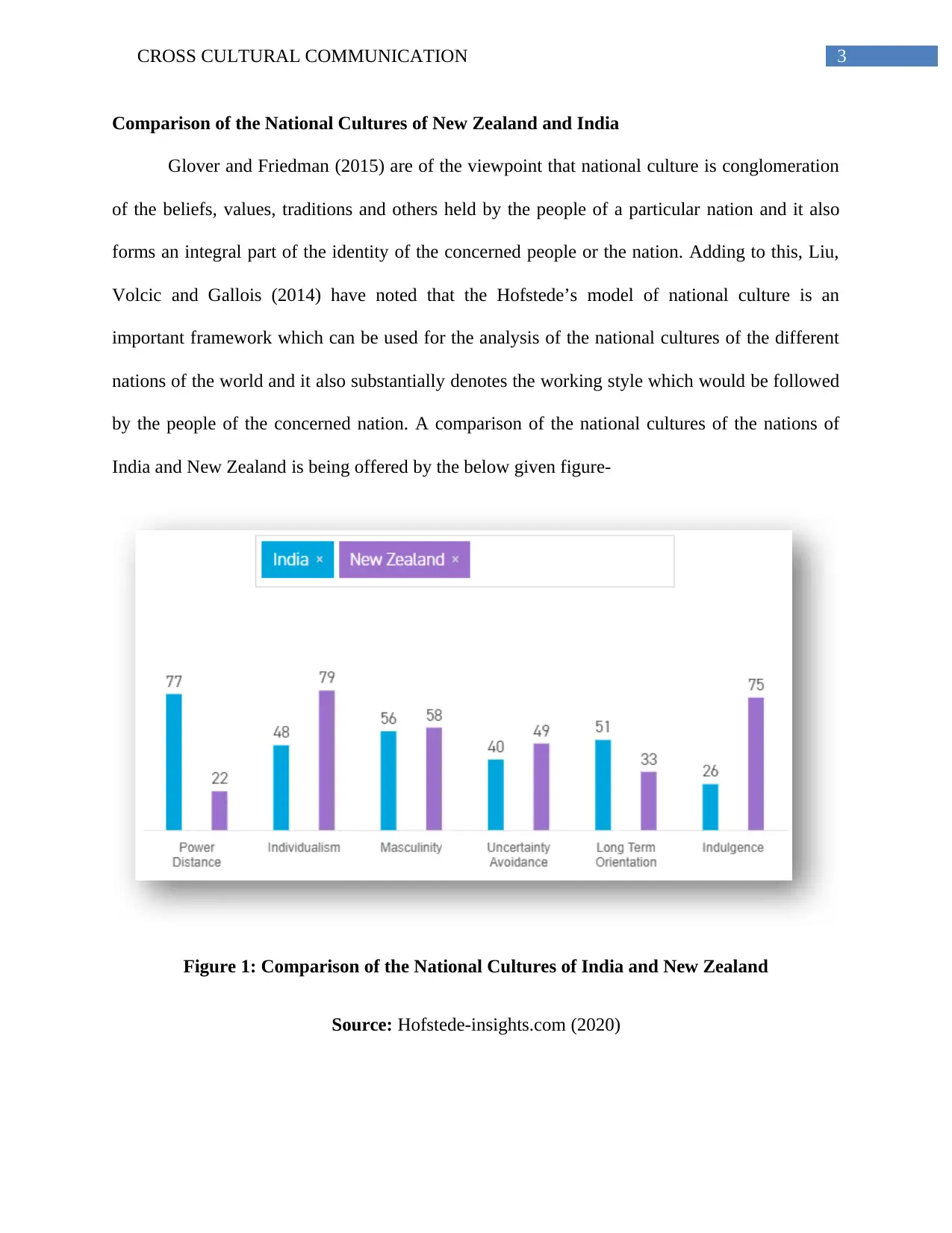
3CROSS CULTURAL COMMUNICATION
Comparison of the National Cultures of New Zealand and India
Glover and Friedman (2015) are of the viewpoint that national culture is conglomeration
of the beliefs, values, traditions and others held by the people of a particular nation and it also
forms an integral part of the identity of the concerned people or the nation. Adding to this, Liu,
Volcic and Gallois (2014) have noted that the Hofstede’s model of national culture is an
important framework which can be used for the analysis of the national cultures of the different
nations of the world and it also substantially denotes the working style which would be followed
by the people of the concerned nation. A comparison of the national cultures of the nations of
India and New Zealand is being offered by the below given figure-
Figure 1: Comparison of the National Cultures of India and New Zealand
Source: Hofstede-insights.com (2020)
Comparison of the National Cultures of New Zealand and India
Glover and Friedman (2015) are of the viewpoint that national culture is conglomeration
of the beliefs, values, traditions and others held by the people of a particular nation and it also
forms an integral part of the identity of the concerned people or the nation. Adding to this, Liu,
Volcic and Gallois (2014) have noted that the Hofstede’s model of national culture is an
important framework which can be used for the analysis of the national cultures of the different
nations of the world and it also substantially denotes the working style which would be followed
by the people of the concerned nation. A comparison of the national cultures of the nations of
India and New Zealand is being offered by the below given figure-
Figure 1: Comparison of the National Cultures of India and New Zealand
Source: Hofstede-insights.com (2020)
Paraphrase This Document
Need a fresh take? Get an instant paraphrase of this document with our AI Paraphraser
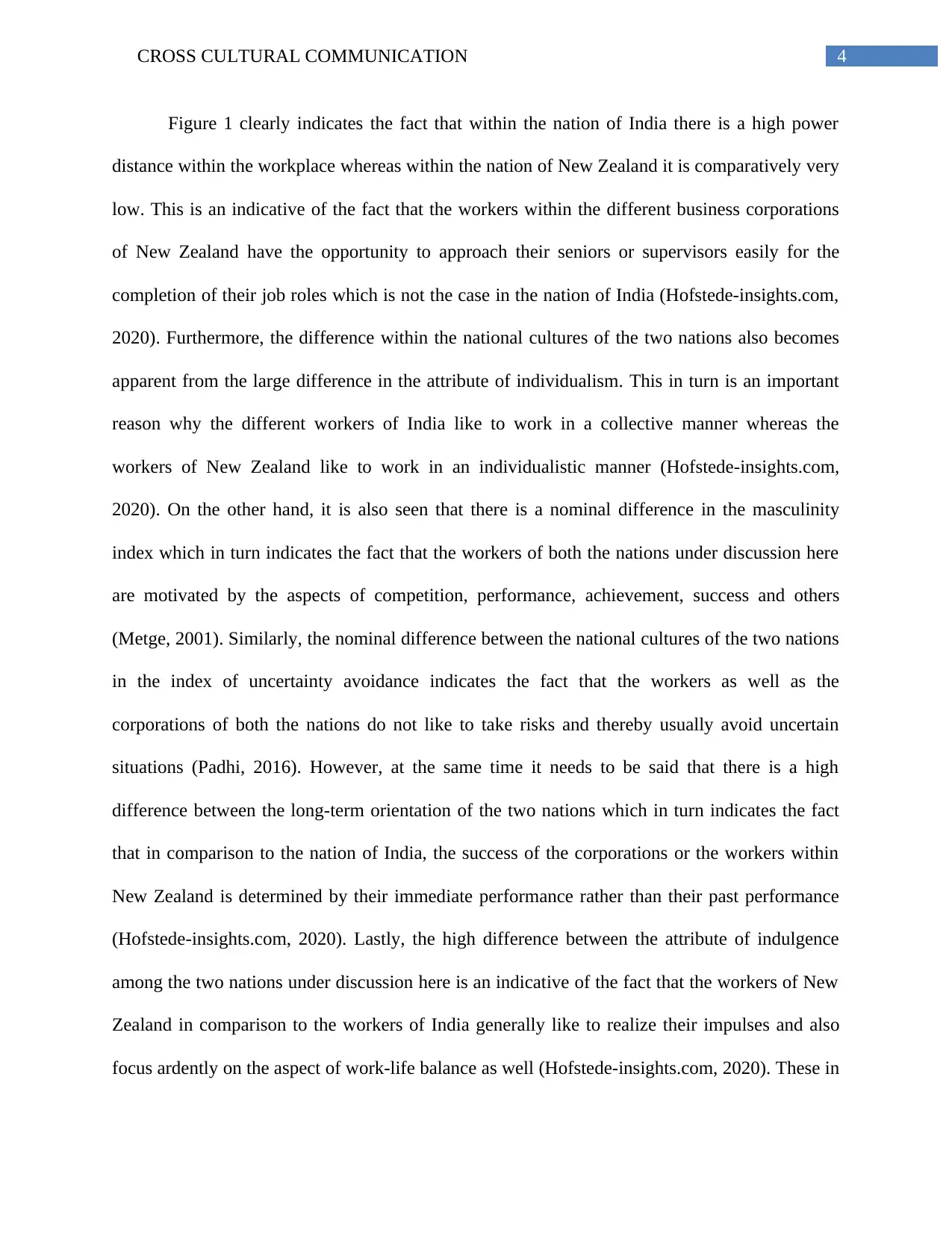
4CROSS CULTURAL COMMUNICATION
Figure 1 clearly indicates the fact that within the nation of India there is a high power
distance within the workplace whereas within the nation of New Zealand it is comparatively very
low. This is an indicative of the fact that the workers within the different business corporations
of New Zealand have the opportunity to approach their seniors or supervisors easily for the
completion of their job roles which is not the case in the nation of India (Hofstede-insights.com,
2020). Furthermore, the difference within the national cultures of the two nations also becomes
apparent from the large difference in the attribute of individualism. This in turn is an important
reason why the different workers of India like to work in a collective manner whereas the
workers of New Zealand like to work in an individualistic manner (Hofstede-insights.com,
2020). On the other hand, it is also seen that there is a nominal difference in the masculinity
index which in turn indicates the fact that the workers of both the nations under discussion here
are motivated by the aspects of competition, performance, achievement, success and others
(Metge, 2001). Similarly, the nominal difference between the national cultures of the two nations
in the index of uncertainty avoidance indicates the fact that the workers as well as the
corporations of both the nations do not like to take risks and thereby usually avoid uncertain
situations (Padhi, 2016). However, at the same time it needs to be said that there is a high
difference between the long-term orientation of the two nations which in turn indicates the fact
that in comparison to the nation of India, the success of the corporations or the workers within
New Zealand is determined by their immediate performance rather than their past performance
(Hofstede-insights.com, 2020). Lastly, the high difference between the attribute of indulgence
among the two nations under discussion here is an indicative of the fact that the workers of New
Zealand in comparison to the workers of India generally like to realize their impulses and also
focus ardently on the aspect of work-life balance as well (Hofstede-insights.com, 2020). These in
Figure 1 clearly indicates the fact that within the nation of India there is a high power
distance within the workplace whereas within the nation of New Zealand it is comparatively very
low. This is an indicative of the fact that the workers within the different business corporations
of New Zealand have the opportunity to approach their seniors or supervisors easily for the
completion of their job roles which is not the case in the nation of India (Hofstede-insights.com,
2020). Furthermore, the difference within the national cultures of the two nations also becomes
apparent from the large difference in the attribute of individualism. This in turn is an important
reason why the different workers of India like to work in a collective manner whereas the
workers of New Zealand like to work in an individualistic manner (Hofstede-insights.com,
2020). On the other hand, it is also seen that there is a nominal difference in the masculinity
index which in turn indicates the fact that the workers of both the nations under discussion here
are motivated by the aspects of competition, performance, achievement, success and others
(Metge, 2001). Similarly, the nominal difference between the national cultures of the two nations
in the index of uncertainty avoidance indicates the fact that the workers as well as the
corporations of both the nations do not like to take risks and thereby usually avoid uncertain
situations (Padhi, 2016). However, at the same time it needs to be said that there is a high
difference between the long-term orientation of the two nations which in turn indicates the fact
that in comparison to the nation of India, the success of the corporations or the workers within
New Zealand is determined by their immediate performance rather than their past performance
(Hofstede-insights.com, 2020). Lastly, the high difference between the attribute of indulgence
among the two nations under discussion here is an indicative of the fact that the workers of New
Zealand in comparison to the workers of India generally like to realize their impulses and also
focus ardently on the aspect of work-life balance as well (Hofstede-insights.com, 2020). These in
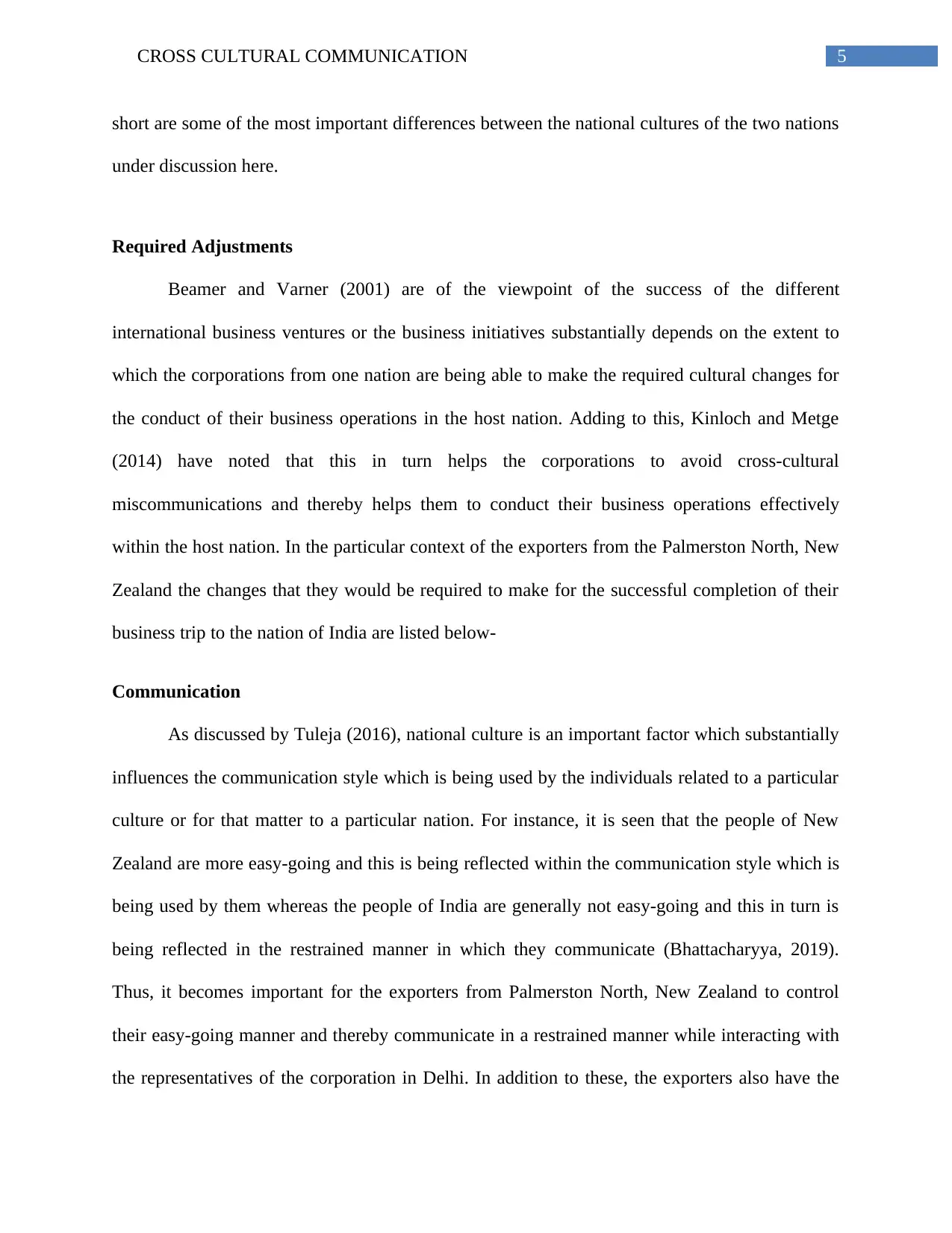
5CROSS CULTURAL COMMUNICATION
short are some of the most important differences between the national cultures of the two nations
under discussion here.
Required Adjustments
Beamer and Varner (2001) are of the viewpoint of the success of the different
international business ventures or the business initiatives substantially depends on the extent to
which the corporations from one nation are being able to make the required cultural changes for
the conduct of their business operations in the host nation. Adding to this, Kinloch and Metge
(2014) have noted that this in turn helps the corporations to avoid cross-cultural
miscommunications and thereby helps them to conduct their business operations effectively
within the host nation. In the particular context of the exporters from the Palmerston North, New
Zealand the changes that they would be required to make for the successful completion of their
business trip to the nation of India are listed below-
Communication
As discussed by Tuleja (2016), national culture is an important factor which substantially
influences the communication style which is being used by the individuals related to a particular
culture or for that matter to a particular nation. For instance, it is seen that the people of New
Zealand are more easy-going and this is being reflected within the communication style which is
being used by them whereas the people of India are generally not easy-going and this in turn is
being reflected in the restrained manner in which they communicate (Bhattacharyya, 2019).
Thus, it becomes important for the exporters from Palmerston North, New Zealand to control
their easy-going manner and thereby communicate in a restrained manner while interacting with
the representatives of the corporation in Delhi. In addition to these, the exporters also have the
short are some of the most important differences between the national cultures of the two nations
under discussion here.
Required Adjustments
Beamer and Varner (2001) are of the viewpoint of the success of the different
international business ventures or the business initiatives substantially depends on the extent to
which the corporations from one nation are being able to make the required cultural changes for
the conduct of their business operations in the host nation. Adding to this, Kinloch and Metge
(2014) have noted that this in turn helps the corporations to avoid cross-cultural
miscommunications and thereby helps them to conduct their business operations effectively
within the host nation. In the particular context of the exporters from the Palmerston North, New
Zealand the changes that they would be required to make for the successful completion of their
business trip to the nation of India are listed below-
Communication
As discussed by Tuleja (2016), national culture is an important factor which substantially
influences the communication style which is being used by the individuals related to a particular
culture or for that matter to a particular nation. For instance, it is seen that the people of New
Zealand are more easy-going and this is being reflected within the communication style which is
being used by them whereas the people of India are generally not easy-going and this in turn is
being reflected in the restrained manner in which they communicate (Bhattacharyya, 2019).
Thus, it becomes important for the exporters from Palmerston North, New Zealand to control
their easy-going manner and thereby communicate in a restrained manner while interacting with
the representatives of the corporation in Delhi. In addition to these, the exporters also have the
⊘ This is a preview!⊘
Do you want full access?
Subscribe today to unlock all pages.

Trusted by 1+ million students worldwide
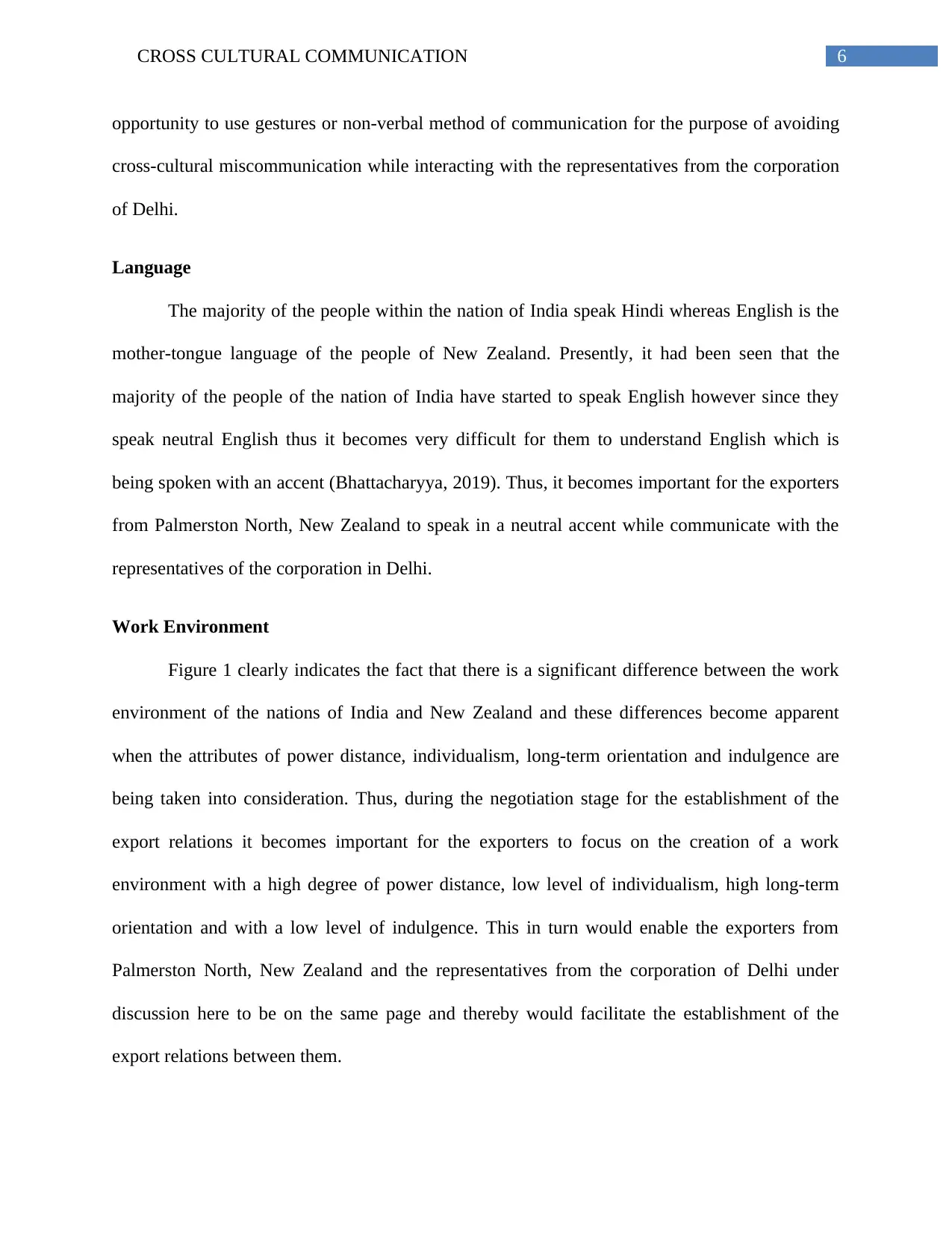
6CROSS CULTURAL COMMUNICATION
opportunity to use gestures or non-verbal method of communication for the purpose of avoiding
cross-cultural miscommunication while interacting with the representatives from the corporation
of Delhi.
Language
The majority of the people within the nation of India speak Hindi whereas English is the
mother-tongue language of the people of New Zealand. Presently, it had been seen that the
majority of the people of the nation of India have started to speak English however since they
speak neutral English thus it becomes very difficult for them to understand English which is
being spoken with an accent (Bhattacharyya, 2019). Thus, it becomes important for the exporters
from Palmerston North, New Zealand to speak in a neutral accent while communicate with the
representatives of the corporation in Delhi.
Work Environment
Figure 1 clearly indicates the fact that there is a significant difference between the work
environment of the nations of India and New Zealand and these differences become apparent
when the attributes of power distance, individualism, long-term orientation and indulgence are
being taken into consideration. Thus, during the negotiation stage for the establishment of the
export relations it becomes important for the exporters to focus on the creation of a work
environment with a high degree of power distance, low level of individualism, high long-term
orientation and with a low level of indulgence. This in turn would enable the exporters from
Palmerston North, New Zealand and the representatives from the corporation of Delhi under
discussion here to be on the same page and thereby would facilitate the establishment of the
export relations between them.
opportunity to use gestures or non-verbal method of communication for the purpose of avoiding
cross-cultural miscommunication while interacting with the representatives from the corporation
of Delhi.
Language
The majority of the people within the nation of India speak Hindi whereas English is the
mother-tongue language of the people of New Zealand. Presently, it had been seen that the
majority of the people of the nation of India have started to speak English however since they
speak neutral English thus it becomes very difficult for them to understand English which is
being spoken with an accent (Bhattacharyya, 2019). Thus, it becomes important for the exporters
from Palmerston North, New Zealand to speak in a neutral accent while communicate with the
representatives of the corporation in Delhi.
Work Environment
Figure 1 clearly indicates the fact that there is a significant difference between the work
environment of the nations of India and New Zealand and these differences become apparent
when the attributes of power distance, individualism, long-term orientation and indulgence are
being taken into consideration. Thus, during the negotiation stage for the establishment of the
export relations it becomes important for the exporters to focus on the creation of a work
environment with a high degree of power distance, low level of individualism, high long-term
orientation and with a low level of indulgence. This in turn would enable the exporters from
Palmerston North, New Zealand and the representatives from the corporation of Delhi under
discussion here to be on the same page and thereby would facilitate the establishment of the
export relations between them.
Paraphrase This Document
Need a fresh take? Get an instant paraphrase of this document with our AI Paraphraser
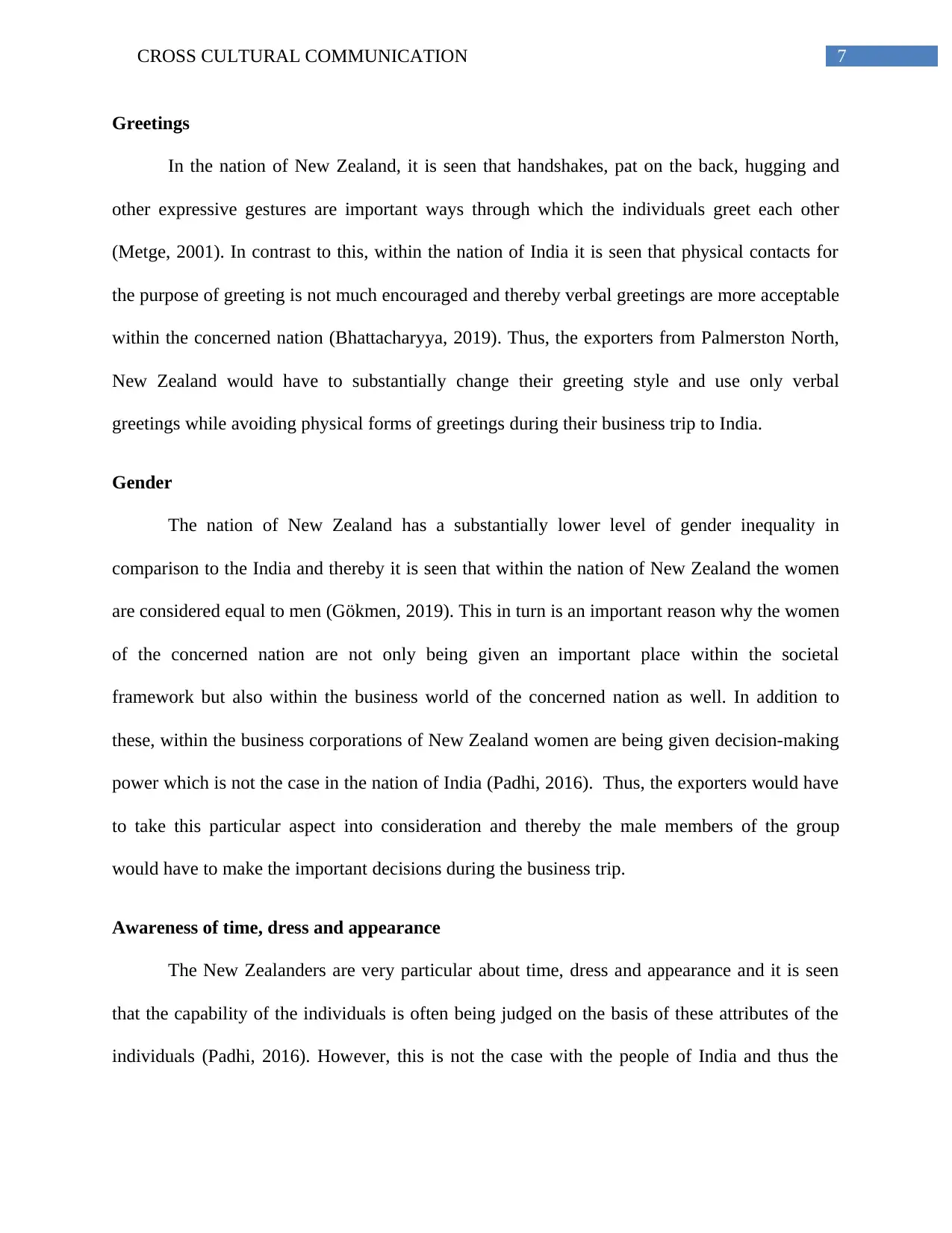
7CROSS CULTURAL COMMUNICATION
Greetings
In the nation of New Zealand, it is seen that handshakes, pat on the back, hugging and
other expressive gestures are important ways through which the individuals greet each other
(Metge, 2001). In contrast to this, within the nation of India it is seen that physical contacts for
the purpose of greeting is not much encouraged and thereby verbal greetings are more acceptable
within the concerned nation (Bhattacharyya, 2019). Thus, the exporters from Palmerston North,
New Zealand would have to substantially change their greeting style and use only verbal
greetings while avoiding physical forms of greetings during their business trip to India.
Gender
The nation of New Zealand has a substantially lower level of gender inequality in
comparison to the India and thereby it is seen that within the nation of New Zealand the women
are considered equal to men (Gökmen, 2019). This in turn is an important reason why the women
of the concerned nation are not only being given an important place within the societal
framework but also within the business world of the concerned nation as well. In addition to
these, within the business corporations of New Zealand women are being given decision-making
power which is not the case in the nation of India (Padhi, 2016). Thus, the exporters would have
to take this particular aspect into consideration and thereby the male members of the group
would have to make the important decisions during the business trip.
Awareness of time, dress and appearance
The New Zealanders are very particular about time, dress and appearance and it is seen
that the capability of the individuals is often being judged on the basis of these attributes of the
individuals (Padhi, 2016). However, this is not the case with the people of India and thus the
Greetings
In the nation of New Zealand, it is seen that handshakes, pat on the back, hugging and
other expressive gestures are important ways through which the individuals greet each other
(Metge, 2001). In contrast to this, within the nation of India it is seen that physical contacts for
the purpose of greeting is not much encouraged and thereby verbal greetings are more acceptable
within the concerned nation (Bhattacharyya, 2019). Thus, the exporters from Palmerston North,
New Zealand would have to substantially change their greeting style and use only verbal
greetings while avoiding physical forms of greetings during their business trip to India.
Gender
The nation of New Zealand has a substantially lower level of gender inequality in
comparison to the India and thereby it is seen that within the nation of New Zealand the women
are considered equal to men (Gökmen, 2019). This in turn is an important reason why the women
of the concerned nation are not only being given an important place within the societal
framework but also within the business world of the concerned nation as well. In addition to
these, within the business corporations of New Zealand women are being given decision-making
power which is not the case in the nation of India (Padhi, 2016). Thus, the exporters would have
to take this particular aspect into consideration and thereby the male members of the group
would have to make the important decisions during the business trip.
Awareness of time, dress and appearance
The New Zealanders are very particular about time, dress and appearance and it is seen
that the capability of the individuals is often being judged on the basis of these attributes of the
individuals (Padhi, 2016). However, this is not the case with the people of India and thus the
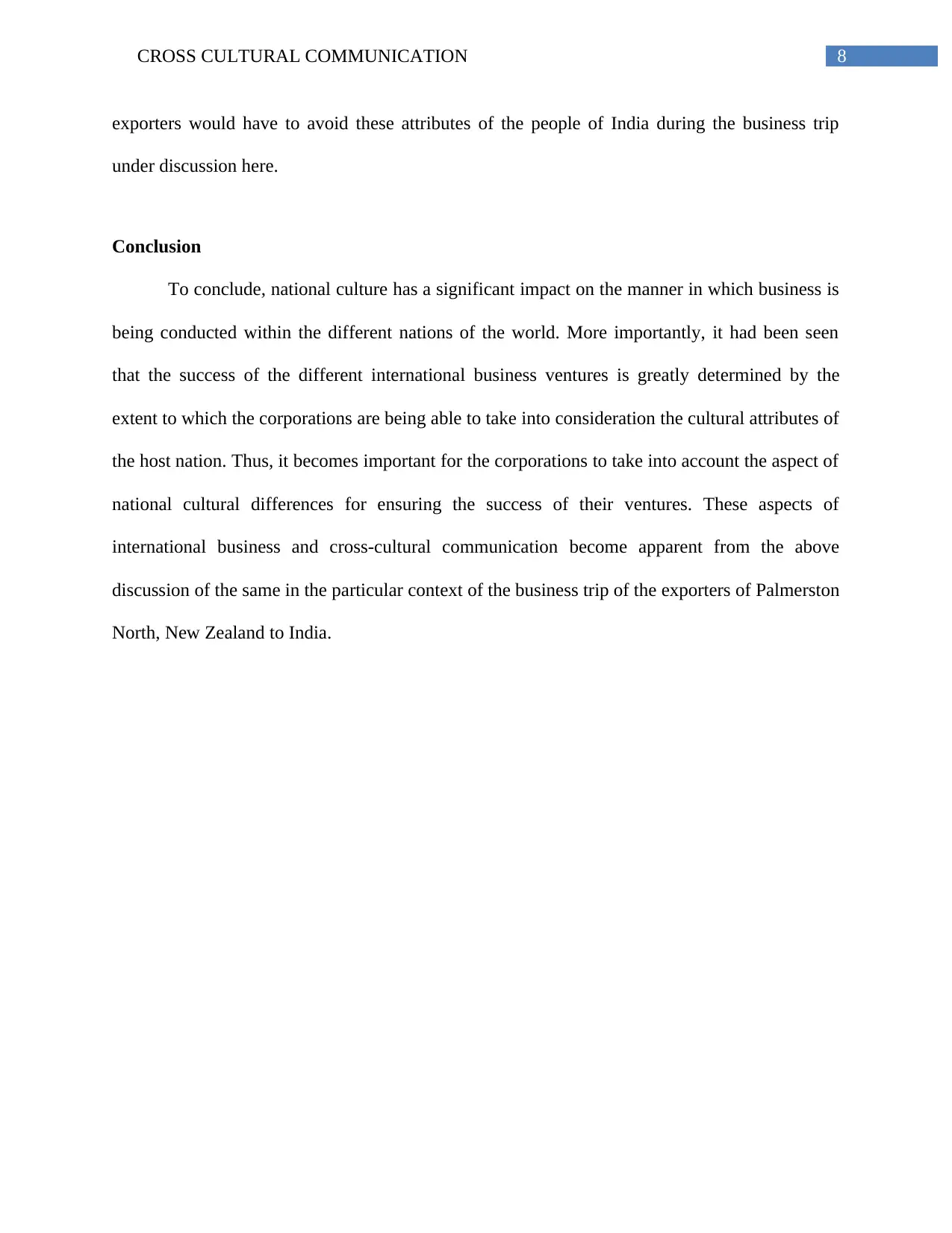
8CROSS CULTURAL COMMUNICATION
exporters would have to avoid these attributes of the people of India during the business trip
under discussion here.
Conclusion
To conclude, national culture has a significant impact on the manner in which business is
being conducted within the different nations of the world. More importantly, it had been seen
that the success of the different international business ventures is greatly determined by the
extent to which the corporations are being able to take into consideration the cultural attributes of
the host nation. Thus, it becomes important for the corporations to take into account the aspect of
national cultural differences for ensuring the success of their ventures. These aspects of
international business and cross-cultural communication become apparent from the above
discussion of the same in the particular context of the business trip of the exporters of Palmerston
North, New Zealand to India.
exporters would have to avoid these attributes of the people of India during the business trip
under discussion here.
Conclusion
To conclude, national culture has a significant impact on the manner in which business is
being conducted within the different nations of the world. More importantly, it had been seen
that the success of the different international business ventures is greatly determined by the
extent to which the corporations are being able to take into consideration the cultural attributes of
the host nation. Thus, it becomes important for the corporations to take into account the aspect of
national cultural differences for ensuring the success of their ventures. These aspects of
international business and cross-cultural communication become apparent from the above
discussion of the same in the particular context of the business trip of the exporters of Palmerston
North, New Zealand to India.
⊘ This is a preview!⊘
Do you want full access?
Subscribe today to unlock all pages.

Trusted by 1+ million students worldwide
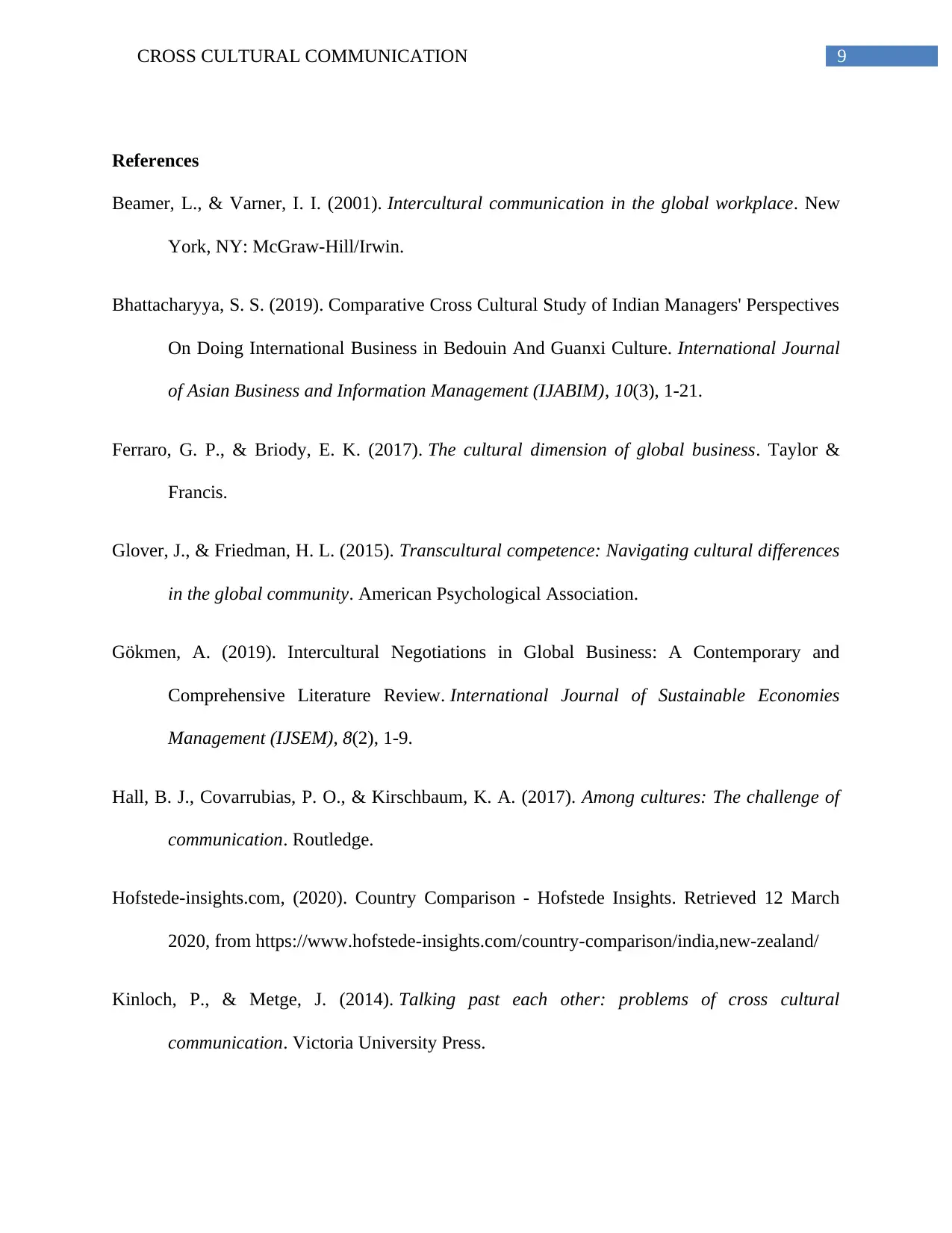
9CROSS CULTURAL COMMUNICATION
References
Beamer, L., & Varner, I. I. (2001). Intercultural communication in the global workplace. New
York, NY: McGraw-Hill/Irwin.
Bhattacharyya, S. S. (2019). Comparative Cross Cultural Study of Indian Managers' Perspectives
On Doing International Business in Bedouin And Guanxi Culture. International Journal
of Asian Business and Information Management (IJABIM), 10(3), 1-21.
Ferraro, G. P., & Briody, E. K. (2017). The cultural dimension of global business. Taylor &
Francis.
Glover, J., & Friedman, H. L. (2015). Transcultural competence: Navigating cultural differences
in the global community. American Psychological Association.
Gökmen, A. (2019). Intercultural Negotiations in Global Business: A Contemporary and
Comprehensive Literature Review. International Journal of Sustainable Economies
Management (IJSEM), 8(2), 1-9.
Hall, B. J., Covarrubias, P. O., & Kirschbaum, K. A. (2017). Among cultures: The challenge of
communication. Routledge.
Hofstede-insights.com, (2020). Country Comparison - Hofstede Insights. Retrieved 12 March
2020, from https://www.hofstede-insights.com/country-comparison/india,new-zealand/
Kinloch, P., & Metge, J. (2014). Talking past each other: problems of cross cultural
communication. Victoria University Press.
References
Beamer, L., & Varner, I. I. (2001). Intercultural communication in the global workplace. New
York, NY: McGraw-Hill/Irwin.
Bhattacharyya, S. S. (2019). Comparative Cross Cultural Study of Indian Managers' Perspectives
On Doing International Business in Bedouin And Guanxi Culture. International Journal
of Asian Business and Information Management (IJABIM), 10(3), 1-21.
Ferraro, G. P., & Briody, E. K. (2017). The cultural dimension of global business. Taylor &
Francis.
Glover, J., & Friedman, H. L. (2015). Transcultural competence: Navigating cultural differences
in the global community. American Psychological Association.
Gökmen, A. (2019). Intercultural Negotiations in Global Business: A Contemporary and
Comprehensive Literature Review. International Journal of Sustainable Economies
Management (IJSEM), 8(2), 1-9.
Hall, B. J., Covarrubias, P. O., & Kirschbaum, K. A. (2017). Among cultures: The challenge of
communication. Routledge.
Hofstede-insights.com, (2020). Country Comparison - Hofstede Insights. Retrieved 12 March
2020, from https://www.hofstede-insights.com/country-comparison/india,new-zealand/
Kinloch, P., & Metge, J. (2014). Talking past each other: problems of cross cultural
communication. Victoria University Press.
Paraphrase This Document
Need a fresh take? Get an instant paraphrase of this document with our AI Paraphraser
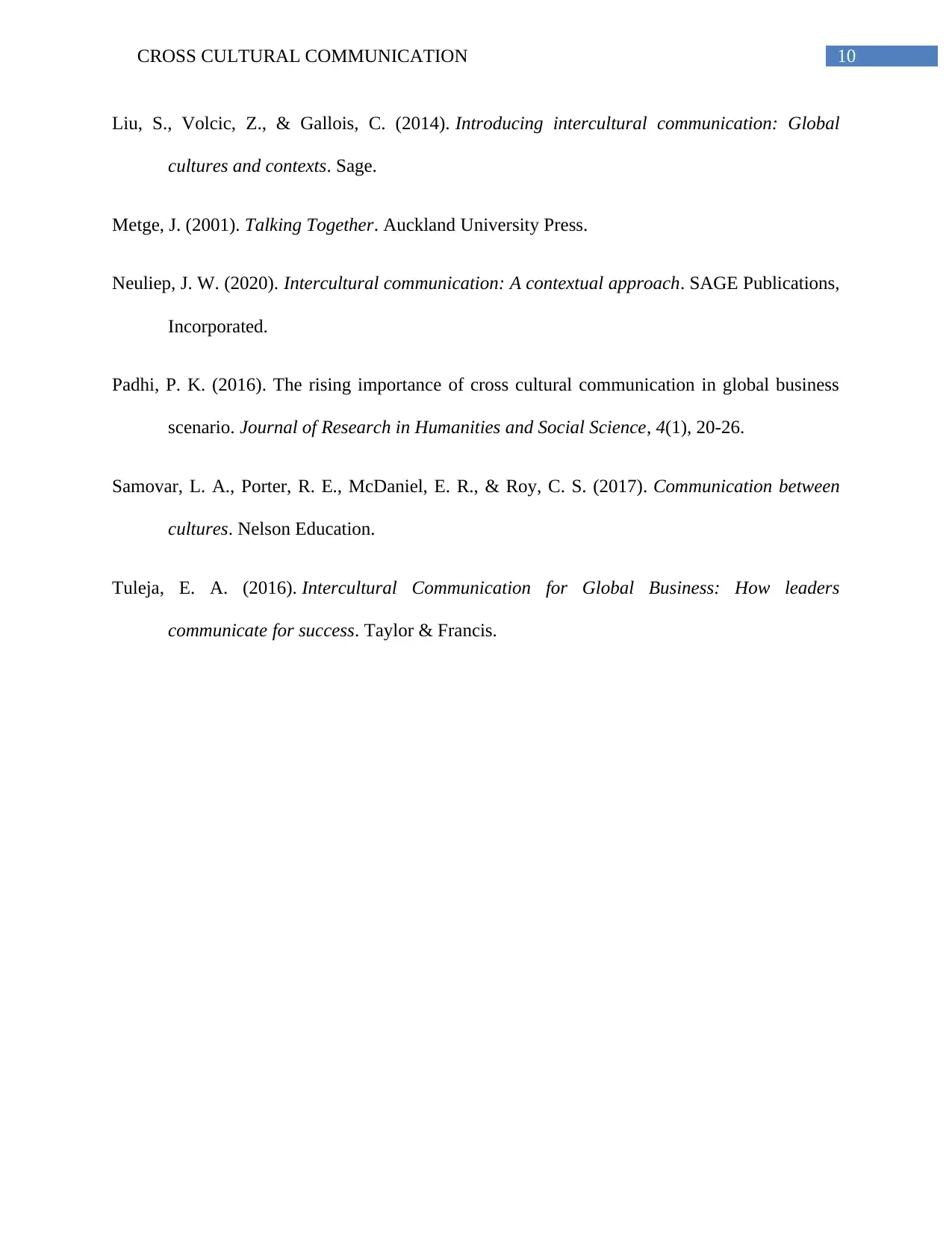
10CROSS CULTURAL COMMUNICATION
Liu, S., Volcic, Z., & Gallois, C. (2014). Introducing intercultural communication: Global
cultures and contexts. Sage.
Metge, J. (2001). Talking Together. Auckland University Press.
Neuliep, J. W. (2020). Intercultural communication: A contextual approach. SAGE Publications,
Incorporated.
Padhi, P. K. (2016). The rising importance of cross cultural communication in global business
scenario. Journal of Research in Humanities and Social Science, 4(1), 20-26.
Samovar, L. A., Porter, R. E., McDaniel, E. R., & Roy, C. S. (2017). Communication between
cultures. Nelson Education.
Tuleja, E. A. (2016). Intercultural Communication for Global Business: How leaders
communicate for success. Taylor & Francis.
Liu, S., Volcic, Z., & Gallois, C. (2014). Introducing intercultural communication: Global
cultures and contexts. Sage.
Metge, J. (2001). Talking Together. Auckland University Press.
Neuliep, J. W. (2020). Intercultural communication: A contextual approach. SAGE Publications,
Incorporated.
Padhi, P. K. (2016). The rising importance of cross cultural communication in global business
scenario. Journal of Research in Humanities and Social Science, 4(1), 20-26.
Samovar, L. A., Porter, R. E., McDaniel, E. R., & Roy, C. S. (2017). Communication between
cultures. Nelson Education.
Tuleja, E. A. (2016). Intercultural Communication for Global Business: How leaders
communicate for success. Taylor & Francis.
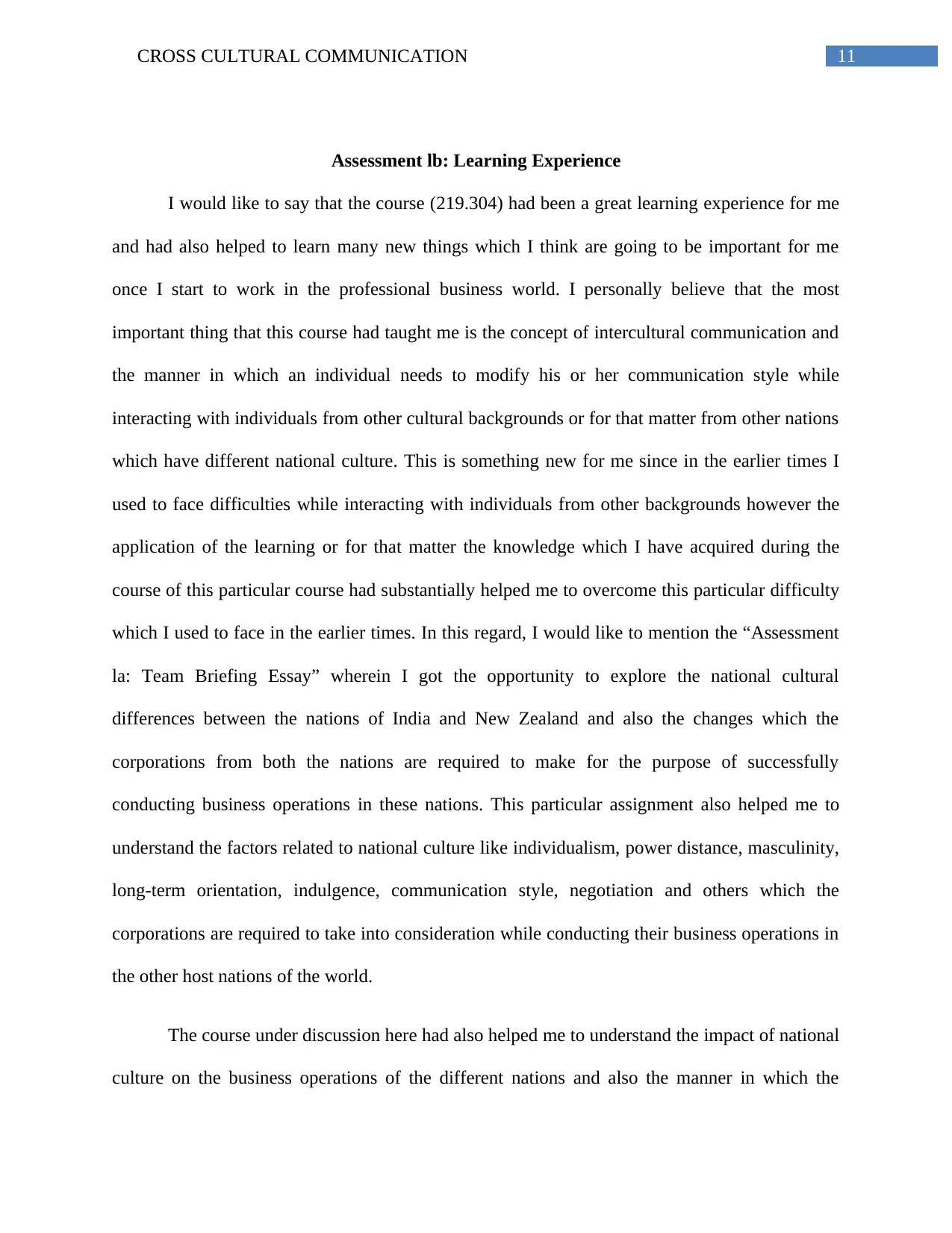
11CROSS CULTURAL COMMUNICATION
Assessment lb: Learning Experience
I would like to say that the course (219.304) had been a great learning experience for me
and had also helped to learn many new things which I think are going to be important for me
once I start to work in the professional business world. I personally believe that the most
important thing that this course had taught me is the concept of intercultural communication and
the manner in which an individual needs to modify his or her communication style while
interacting with individuals from other cultural backgrounds or for that matter from other nations
which have different national culture. This is something new for me since in the earlier times I
used to face difficulties while interacting with individuals from other backgrounds however the
application of the learning or for that matter the knowledge which I have acquired during the
course of this particular course had substantially helped me to overcome this particular difficulty
which I used to face in the earlier times. In this regard, I would like to mention the “Assessment
la: Team Briefing Essay” wherein I got the opportunity to explore the national cultural
differences between the nations of India and New Zealand and also the changes which the
corporations from both the nations are required to make for the purpose of successfully
conducting business operations in these nations. This particular assignment also helped me to
understand the factors related to national culture like individualism, power distance, masculinity,
long-term orientation, indulgence, communication style, negotiation and others which the
corporations are required to take into consideration while conducting their business operations in
the other host nations of the world.
The course under discussion here had also helped me to understand the impact of national
culture on the business operations of the different nations and also the manner in which the
Assessment lb: Learning Experience
I would like to say that the course (219.304) had been a great learning experience for me
and had also helped to learn many new things which I think are going to be important for me
once I start to work in the professional business world. I personally believe that the most
important thing that this course had taught me is the concept of intercultural communication and
the manner in which an individual needs to modify his or her communication style while
interacting with individuals from other cultural backgrounds or for that matter from other nations
which have different national culture. This is something new for me since in the earlier times I
used to face difficulties while interacting with individuals from other backgrounds however the
application of the learning or for that matter the knowledge which I have acquired during the
course of this particular course had substantially helped me to overcome this particular difficulty
which I used to face in the earlier times. In this regard, I would like to mention the “Assessment
la: Team Briefing Essay” wherein I got the opportunity to explore the national cultural
differences between the nations of India and New Zealand and also the changes which the
corporations from both the nations are required to make for the purpose of successfully
conducting business operations in these nations. This particular assignment also helped me to
understand the factors related to national culture like individualism, power distance, masculinity,
long-term orientation, indulgence, communication style, negotiation and others which the
corporations are required to take into consideration while conducting their business operations in
the other host nations of the world.
The course under discussion here had also helped me to understand the impact of national
culture on the business operations of the different nations and also the manner in which the
⊘ This is a preview!⊘
Do you want full access?
Subscribe today to unlock all pages.

Trusted by 1+ million students worldwide
1 out of 14
Related Documents
Your All-in-One AI-Powered Toolkit for Academic Success.
+13062052269
info@desklib.com
Available 24*7 on WhatsApp / Email
![[object Object]](/_next/static/media/star-bottom.7253800d.svg)
Unlock your academic potential
Copyright © 2020–2025 A2Z Services. All Rights Reserved. Developed and managed by ZUCOL.




